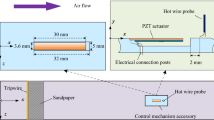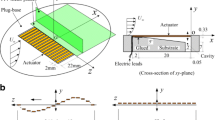Abstract
In order to manipulate large-scale coherent structures in the wall-bounded turbulence and reduce the skin-friction, an active-control experimental investigation was performed through synchronous and asynchronous vibrations of double piezoelectric vibrators embedded spanwisely on a smooth flat plate surface. A TSI-IFA300 hot-wire anemometer and TSI-1621A-T1.5 hot-wire probe were used to measure the time series of instantaneous velocity at different locations. Influence of the vibrations on wall-bounded turbulence are compared in a multi-scale point of view. A disturbance Reynolds Number Red = ρd2f/μ is introduced to represent the disturbance. A probability density functions (PDFs) of the multi-scale components of the turbulence velocity and multi-scale conditional phase-averaged waveform are studied in detail using the Wavelet transform. The results show that the maximum drag reduction rate 18.54% was obtained at 100V/160Hz and Red = 0.54 case with an asynchronous vibration mode. The disturbances generated by the vibrators have a significant influence on the sweep events of burst. The asynchronous vibration model is more effective than synchronous vibration one. A possible physical mechanism is recognized to explain why the disturbance frequency of 160Hz leads to an optimal parameter set for drag reduction.
Similar content being viewed by others
References
Pope S. B. Turbulent flows [M]. Cambridge, UK: Cambridge University Press, 2001.
Wallace J. M. Highlights from 50 years of turbulent boundary layer research [J]. Journal of Turbulence, 2012, 13(53): 53.
Hutchins N., Marusic I. Large-scale influences in near-wall turbulence [J]. Philosophical Transactions of the Royal Society A: Mathematical, Physical and Engineering Sciences, 2007, 365(1852): 647–664.
Oberlack M. A unified approach for symmetries in plane parallel turbulent shear flows [J]. Journal of Fluid Mechanics, 2001, 1: 299–328.
GAD-EL-HAK, M. Flow Control: Passive, active and reactive flow management [M]. Cambridge, UK: Cambridge University Press, 2000.
Lumley J., Blossey P. Control of turbulence [J]. Annual Review of Fluid Mechanics, 1998, 30(1): 311–327.
James W. G., Kevin G., Mayhew B. Characterization of super-hydrophobic surfaces for drag reduction in turbulent flow [J]. Journal of Fluid Mechanics, 2018, 1: 560–580.
Kruse N., Kuhn S., Von Rohr P R. Wavy wall effects on turbulence production and large-scale modes [J]. Journal of Turbulence, 2006, 7(31): N31.
Fukagata K., Kern S., Chatelain P. et al. Evolutionary optimization of an anisotropic compliant surface for turbulent friction drag reduction [J]. Journal of Turbulence, 2008.
Jiménez J. Turbulent flows over rough wall [J]. Annual Review of Fluid Mechanics, 2004, 36(1): 173–196.
Cattafesta L. N., Sheplak M. Actuators for active flow control [J]. Annual Review of Fluid Mechanics, 2011, 43(1): 247–272.
Segawa T., Kawaguchi Y., Kikushima Y. et al. Active control of streak structures in wall turbulence using an actuator array producing inclined wavy disturbances [J]. Journal of Turbulence, 2002, 3(1): 1–15.
Itoh, M., Tamano S., Yokota K., et al. Drag reduction in a turbulent boundary layer on a flexible sheet undergoing a spanwise traveling wave motion [J]. Journal of Turbulence, 2006, 7(27): 1–17.
Choi K. S., Jukes T., Whalley R. Turbulent boundary-layer control with plasma actuators [J]. Philosophical Transactions of the Royal Society A Mathematical Physical and Engineering Sciences, 2011, 1: 1443–1458.
Quadrio M., Ricco P. Critical assessment of turbulent drag reduction through spanwise wall oscillations [J]. Journal of Fluid Mechanics, 2004, 1: 251–271.
Tang Z. Q., Jiang N., Zheng X. B. et al. Local dynamic perturbation effects on amplitude modulation in turbulent boundary layer flow based on triple decomposition [J]. physics of Fluids, 2019, 31(2).
Bai H. L., Zhou Y., Zhang W. G. et al. Active control of a turbulent boundary layer based on local surface perturbation [J]. Journal of Fluid Mechanics, 2014, 1: 316–354.
Rathnasingham R. System identification and active control of a turbulent boundary layer [J]. physics of Fluids, 1997, 9(7): 1867–1869.
Cattafesta L. N., Garg S., Shukla D. Development of piezoelectric actuators for active flow control [J]. Journal of AIAA, 2001, 39(8): 1562–1568.
Bai H. L., Zhou Y. Active control of turbulent boundary layer using an array of piezo-ceramic actuators [J]. Springer Proceedings in Physics, 2009, 1: 201–204.
Zheng X. B., Jiang N., Zhang H. Predetermined control of turbulent boundary layer with a piezoelectric oscillator [J]. Chinese Physics B, 2016, 25(1): 669–673.
Ruppert-Felsot J., Farge M., Petitjeans P. Wavelet tools to study intermittency: application to vortex bursting [J]. Journal of Fluid Mechanics, 2009, 636:427.
Adrian R. J. Hairpin vortex organization in wall turbulence [J]. Physics of Fluids, 2007, 19(4): 457.
Bai J. X., Jiang N., Zheng X. B. et al. Active control of wall-bounded turbulence for drag reduction with piezoelectric oscillators [J]. Chinese Physics B, 2018, 27(07): 402–408.
Jiang N., Liu W., Liu J. H. et al. Phase-averaged waveform of Reynolds stress in wall turbulence during the burst events of coherent structures [J]. Science in China, 2008, 51(7): 857–866.
Author information
Authors and Affiliations
Corresponding author
Additional information
Project supported by the National Natural Science Foundation of China (Grant Nos. 11732010, 11972251, 11872272, 11902218, 11802195)
Biography: Jian-xia Bai (1982-), Female, Ph. D.
Rights and permissions
About this article
Cite this article
Bai, Jx., Huang, Yx., Jiang, N. et al. Experimental investigation of wall-bounded turbulence drag reduction by active control of double piezoelectric vibrator. J Hydrodyn 32, 747–757 (2020). https://doi.org/10.1007/s42241-020-0014-4
Received:
Revised:
Accepted:
Published:
Issue Date:
DOI: https://doi.org/10.1007/s42241-020-0014-4




